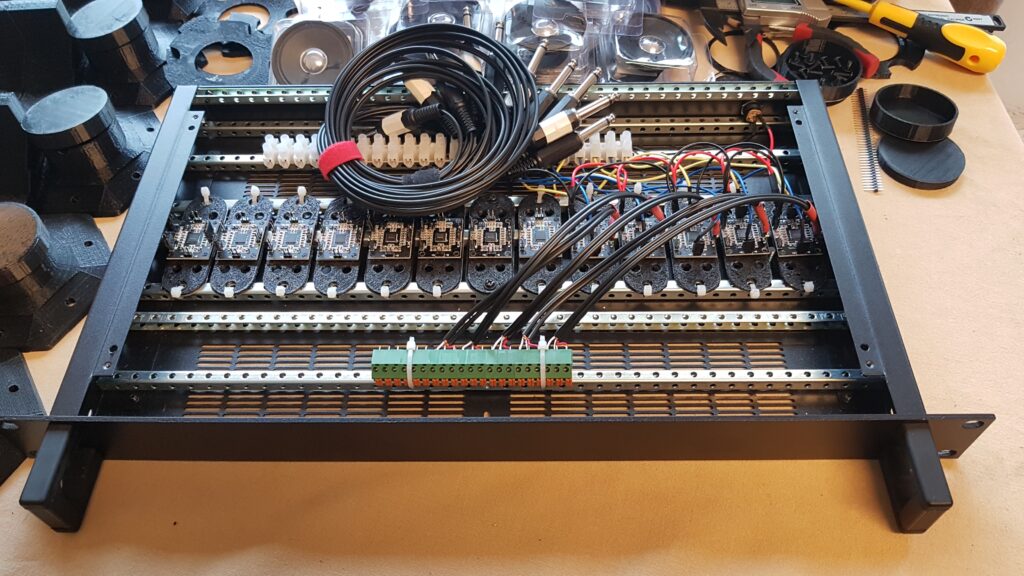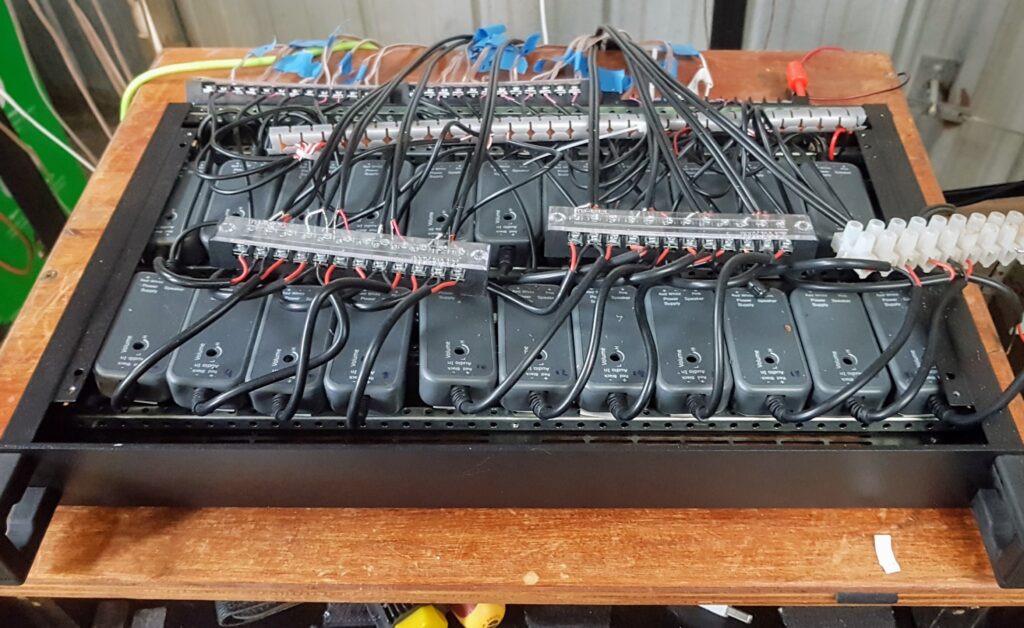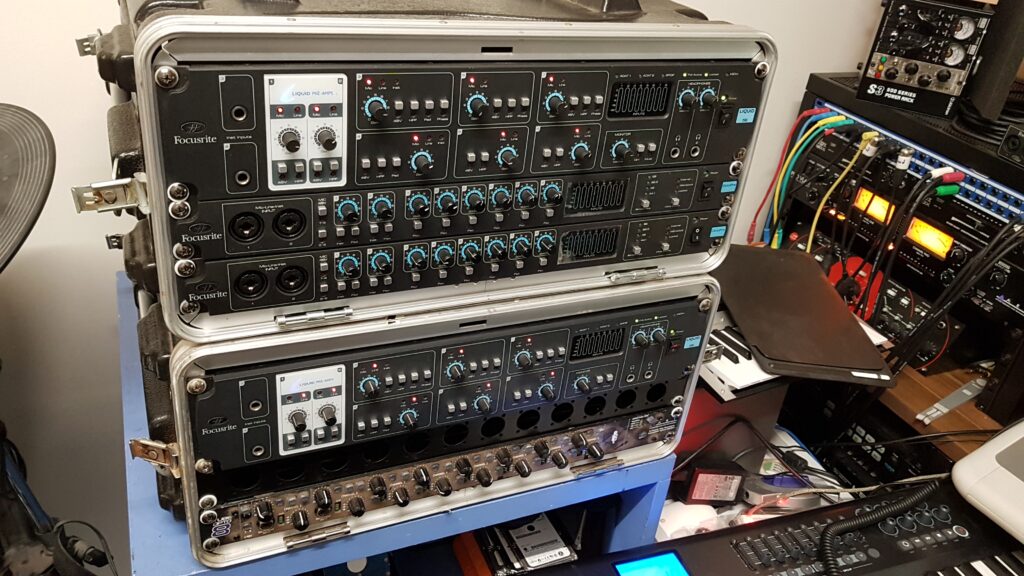The audio
My vision for this project was to create an ambisonic dome for tinkerers and musicians who have a tiny budget but don’t mind putting in some DIY time. One of the biggest hurdles for keeping the dome design affordable was working out how the audio amplifiers and computer interfaces could be made or found cheaply.
Amplifiers can be very cheap when you need one or two channels – any Hi-Fi amplifier will do. If you want up to 6 channels you might be able to re-purpose an old surround-sound amplifier. You can’t get 26 channels of ready-made audio cheaply. Commercial power amps that handle over 16 channels are thousands of dollars. It was obvious that I would have to make something myself.
Digital amplifiers
I have been impressed by some of the small digital amplifiers available through Ali Express and Ebay. They can run from a huge range of voltages, deliver lots of power and are typically quite compact.

$20 per channel is still far too expensive for powering the dome – I’ll need 26 channels of audio. You can, if you look a bit harder, find digital power amplifiers sold in a very basic form, just a PCB and few support components. I found the PAM8610 stereo amplifier for $3.45
Digital amplifiers are very, very efficient and can operate without heatsinks for low power loads. The speakers in my dome are very small, but there are a lot of them. Sounds, even very directional ones, are represented in the dome by an array of speakers sharing the load, keeping the power demand on each speaker small. These little modules seemed perfect and my first test module seemed to perform OK. I ordered a whole pile of them and started on an enclosure.

For each stereo module I 3D printed a mounting ‘sled’. The sled had push-fit fingers that held the modules in place, wire routing holes and mounting holes that could take an M3 bolt or a small cable-tie. It went together very quickly, looked neat and could be powered from a single 12V laptop power supply. It was also unusable.
I had noticed a small amount of noise during my individual module tests but I was entirely unprepared for the wall of noise that 26 channels of the PAM8610 would put out. It wasn’t only hiss – these units were interfering with each other, causing some very harsh noise components. I leveraged my years of experience fighting feedback squeal in valve amplifier designs and re-routed the grounds and power supply lines with a star-topology. A small improvement. I bypassed the power supply on each board with an MKT capacitor and added filtering at the power entry. Another small improvement but not enough. I had a week left before I had to exhibit the dome and I still did not have a working amplifier, so I needed to change course and try something different.
Old fashioned linear amplifiers are also available in chip form – though they can be annoying to work with at medium power, needing heatsinks or direct mounting on a metal case to keep them from destroying themselves through waste heat. I didn’t have time for all that, but I remembered that Jaycar stocked pre-made encapsulated amplifier modules. I bought every one they had and bulk ordered more than they probably would have sold in a year.

The amplifiers were sorted, but I still had to route sound to the dome from my computer. This is another area where a small number of channels is very inexpensive – stereo and even 5.1 surround sound is often built into motherboards or available on a cheap USB dongle. Finding 16 channels will probably cost you ~$2000, and 32 channels ~$4000. Although I would love to be able to justify buying an Orion 32+ from Antelope Audio, that would be overkill for this project. I also don’t have $4000 to spend for fun.
Whatever happened to FireWire?
FireWire equipment is available at bargain prices, if you are willing to take a risk on second-hand gear. FireWire used to be the only connectivity choice for professionals – unless you had some kind of solution that came with its own PCI card and bespoke connectors. USB was too unstable, too slow and had an air of “Intel PC” about it when everyone was using Apple to get creative work done. Then everything changed. Windows became stable (or stable enough depending on your luck and hardware) and Apple forgot that their professional users even existed, abandoning the Mac Pro and removing ports and functionality from their Pro laptops. It became nearly impossible to guess if your expensive interface would survive Apple’s next operating system upgrade. I have a graveyard of interfaces that no longer work with Apple computers – Focusrite, Digi, Edirol, Steinberg, Tascam, IK and others that I have forgotten about that now reside in dusty boxes in the shed.
There are a lot of FIreWire interfaces out there that are still compatible with current operating systems and doing good work but Firewire is obsolete technology and the prices really reflect that. You can buy large capacity systems cheaply but you have to be very careful what hardware you buy. Your hardware choices may restrict you to a few compatible versions of your operating system, preventing you from upgrading until you sell it. The interfaces I am using now are compatible with MacOS 12 but will probably not work for much longer.

I already owned a Focusrite Liquid Saffire 56 with a pair of additional 8-channel optical inputs. It was a great inexpensive system for recording live bands. I was able to find a second 56 for ~$600. Focusrite FIrewire interfaces have a special mode called ‘Twin Linking’ where the driver software ties two interfaces together as one unit. The documentation says that you can NOT link two 56s together – but you can. This configuration is not allowed by Focusrite because, with every input and output channel running, it is possible to exceed the maximum bandwidth of the Firewire 400 connection. Fair enough – but they don’t stop you from just doing it anyway. My only concern is to push 26 channels of audio out of the computer to run my dome and they are able to handle it brilliantly for a fraction of the price of a 32 channel interface.
Since writing this entry I have changed the hardware setup several times. I discovered a cheaper hardware combination that pairs two old Alesis ADAT recorders with the Liquid Saffire 56. ADAT units are currently $100 or less each. The drawback of using the first generation black case ADATs is a fixed -10dB output from the converters, which has to be matched to the +4dB outputs of the Saffire. I modified the dome software to store presets for individual channel gain and the problem was fixed. Later ADAT units (with silver cases) can output at +4dB.

In the interests of maintaining compatibility with modern operating systems into the future I am transitioning the dome to combination of an RME Fireface 800 and two Behringer ADA8200 ADAT converters. RME have an excellent record of keeping every one of their interface drivers up to date. Their very first Firewire interface is still supported. The ungainly chain of dongles required to attach it to my M1 Mac Mini (Thunderbolt 3 to Thunderbolt 2 to Firewire 800) is rock solid in daily use. Eventually I will probably abandon Firewire and move to the RME Digiface USB. This tiny interface is just a box of ADAT lightpipe ports, allowing me to connect four ADA8200 units for 32 output channels.
